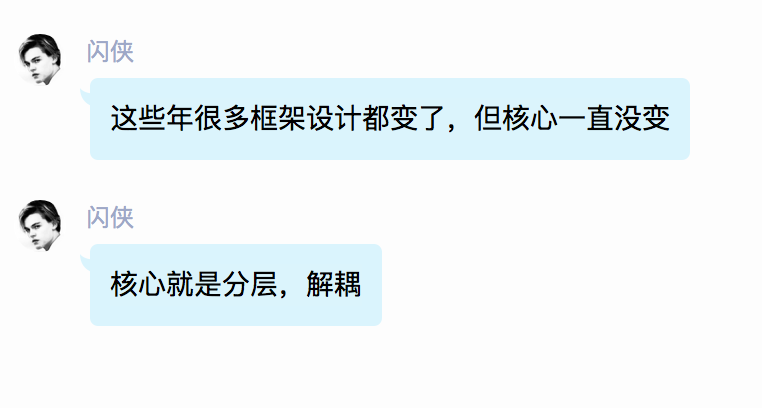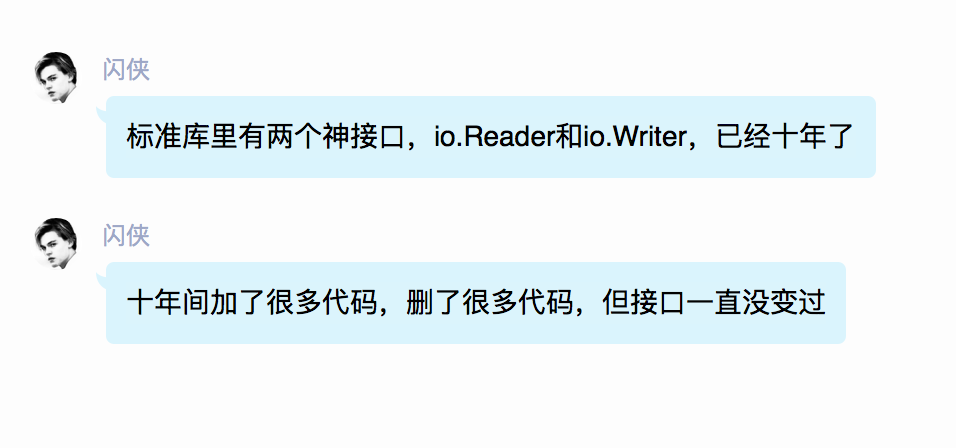[简述] http://goim.io 实例讲解 goim 从 kafka 切换到 nats 的定制过程, 兼谈 谈 golang 的 interface 解耦合, 及 gRPC 在多语言网元之间实现解耦合接口的优点
goim 文章系列(共5篇):
- goim 架构与定制
- 从goim定制, 浅谈 golang 的 interface 解耦合与gRPC
- goim中的 bilibili/discovery (eureka)基本概念及应用
- goim 的 data flow 数据流
- goim的业务集成(分享会小结与QA)
有个 slack 频道, 不少朋友在交流 goim , 欢迎加入slack #goim
0. 背景及动机
继上一篇文章 goim 架构与定制 , 再谈 goim 的定制扩展, 这一次谈一弹 goim 从 kafka 转到 nats
github 上的 issue 在这里https://github.com/Terry-Mao/goim/issues/262
简要说明一下 golang 的 interface: 在 吴德宝AllenWu 文章Golang interface接口深入理解 中这样写到:
为什么要用接口呢?在Gopher China 上的分享中,有大神给出了下面的理由:
writing generic algorithm (类似泛型编程) hiding implementation detail (隐藏具体实现) providing interception points (提供拦截点—–> 也可称叫提供 HOOKS , 一个插入其他业务逻辑的钩子)
换个方式说, interface 就是 de-couple 解耦合在 golang 中的实施, 这是现代编程中比较重要的"分层, 解耦合” 架构设计方法
在QQ群"golang中国” 中, 有关于 de-couple 解耦合的话题中, 闪侠这样说到:


这里, 就来看看 interface 如何实现 goim 从 kafka 转到 NATS
1. goim 中的 kafka
看图, 不说话, 哈哈

上图中,
- 在 logic 这个网元中, 有 logic 向 kafka 的消息发布
- 在 job 网元中, job 从 kafka 订阅消息, 再赂 comet 网元分发
那我们的目标很简单了, 换了!!! ———-> 等等…….能保留原有 kafka 实现不? 在必要时, 可以使用开关项, 切换 nats 或 kafka ??
当然……可以!
2. Don't talk, show me the code!!
下面就比较简单, 看码
2.1 发布接口第一步, 阅读原代码
先看源代码( 注意下面代码中的注释)
代码在 https://github.com/Terry-Mao/goim/blob/master/internal/logic/push.go 大约第33行
// PushMids push a message by mid.
func (l *Logic) PushMids(c context.Context, op int32, mids []int64, msg []byte) (err error) {
keyServers, _, err := l.dao.KeysByMids(c, mids)
if err != nil {
return
}
keys := make(map[string][]string)
for key, server := range keyServers {
if key == "" || server == "" {
log.Warningf("push key:%s server:%s is empty", key, server)
continue
}
keys[server] = append(keys[server], key)
}
for server, keys := range keys {
//
// 主要向 kafka 发送消息, 是下面这一行
// l.dao.PushMsg(c, op, server, keys, msg)
// 方法名是 PushMsg
//
if err = l.dao.PushMsg(c, op, server, keys, msg); err != nil {
return
}
}
return
}
再看一下 dao 是什么:
代码在 https://github.com/Terry-Mao/goim/blob/master/internal/logic/logic.go 大约第20行
// Logic struct
type Logic struct {
c *conf.Config
dis *naming.Discovery
//
//
// 下面这个 dao.Dao 提供了 PushMsg 方法
// 带个星, 这是个引用
//
//
dao *dao.Dao
// online
totalIPs int64
totalConns int64
roomCount map[string]int32
// load balancer
nodes []*naming.Instance
loadBalancer *LoadBalancer
regions map[string]string // province -> region
}
最后, 重点来了, 查到 dao 源头实现
下面是我们需要扩展的地方, 在 https://github.com/Terry-Mao/goim/blob/master/internal/logic/dao/中 dao, 这名称很 java (DAO——-> Data Access Objects 数据存取对象), 这里也说明了 bilibili 们在代码纺织上, 挺规范
代码在 https://github.com/Terry-Mao/goim/blob/master/internal/logic/dao/dao.go 大约第10行开始
// Dao dao.
type Dao struct {
c *conf.Config
//
// ******************************************************************
// 下面这个 kafkaPub 很清楚, 是 kafka 的同步发布者 kafka.SyncProducer
//
// 这个是我们要换成 interface 的地方
//
// ******************************************************************
//
kafkaPub kafka.SyncProducer
redis *redis.Pool
redisExpire int32
}
// New new a dao and return.
func New(c *conf.Config) *Dao {
d := &Dao{
c: c,
//
// ******************************************************************
// 下面这个 newKafkaPub(c.Kafka) 即是初始化 kafka
// 也就是连接上 kafka
// 下面, 我们先改写一下这个函数, 变通一下代码形式
//
// ******************************************************************
//
kafkaPub: newKafkaPub(c.Kafka),
redis: newRedis(c.Redis),
redisExpire: int32(time.Duration(c.Redis.Expire) / time.Second),
}
return d
}
// 这是连接 kafka 的初化函数( function )
//
func newKafkaPub(c *conf.Kafka) kafka.SyncProducer {
kc := kafka.NewConfig()
kc.Producer.RequiredAcks = kafka.WaitForAll // Wait for all in-sync replicas to ack the message
kc.Producer.Retry.Max = 10 // Retry up to 10 times to produce the message
kc.Producer.Return.Successes = true
pub, err := kafka.NewSyncProducer(c.Brokers, kc)
if err != nil {
panic(err)
}
return pub
}
这里, 先小改一下 func New(c *conf.Config) *Dao 这个函数 改成如下代码形式
// New new a dao and return.
func New(c *conf.Config) *Dao {
d := &Dao{
c: c,
//
//
// 注意, 下面这行被移出去
// kafkaPub: newKafkaPub(c.Kafka),
//
//
redis: newRedis(c.Redis),
redisExpire: int32(time.Duration(c.Redis.Expire) / time.Second),
}
//
// 变成这样了, 功能没变化
//
d.kafkaPub = newKafkaPub(c.Kafka)
return d
}
2.2 发布接口第二步, 检查一下哪个方法( method )需要被 interface 实现
还是看源代码
代码在 https://github.com/Terry-Mao/goim/blob/master/internal/logic/dao/kafka.go 大约第13行开始
// PushMsg push a message to databus.
func (d *Dao) PushMsg(c context.Context, op int32, server string, keys []string, msg []byte) (err error) {
pushMsg := &pb.PushMsg{
Type: pb.PushMsg_PUSH,
Operation: op,
Server: server,
Keys: keys,
Msg: msg,
}
b, err := proto.Marshal(pushMsg)
if err != nil {
return
}
//
// ********************************
//
// 实际发布消息, 就是下面这个几行语句
// 1. 组织一下需要发送的信息, 以 kafka 的发布接口要求的形式
// 2. 尝试发布信息, 处理发布信息可能的错误
//
// 重点注意下面这几行, 后面会改掉
// 重点注意下面这几行, 后面会改掉
// 重点注意下面这几行, 后面会改掉
//
// ********************************
//
m := &sarama.ProducerMessage{
Key: sarama.StringEncoder(keys[0]),
Topic: d.c.Kafka.Topic,
Value: sarama.ByteEncoder(b),
}
if _, _, err = d.kafkaPub.SendMessage(m); err != nil {
log.Errorf("PushMsg.send(push pushMsg:%v) error(%v)", pushMsg, err)
}
return
}
// BroadcastRoomMsg push a message to databus.
func (d *Dao) BroadcastRoomMsg(c context.Context, op int32, room string, msg []byte) (err error) {
pushMsg := &pb.PushMsg{
Type: pb.PushMsg_ROOM,
Operation: op,
Room: room,
Msg: msg,
}
b, err := proto.Marshal(pushMsg)
if err != nil {
return
}
m := &sarama.ProducerMessage{
Key: sarama.StringEncoder(room),
Topic: d.c.Kafka.Topic,
Value: sarama.ByteEncoder(b),
}
//
// ********************************
// 实际发布消息, 就是下面这个语句
// ********************************
//
if _, _, err = d.kafkaPub.SendMessage(m); err != nil {
log.Errorf("PushMsg.send(broadcast_room pushMsg:%v) error(%v)", pushMsg, err)
}
return
}
2.3 换用 interface 实现这个 SendMessage(m) 方法( method )
先上代码, 代码会说话( golang 简单就在这里, 代码会说话 ) , 后加说明
// PushMsg interface for kafka / nats
// ******************** 这里是新加的 interface 定义 *****************
type PushMsg interface {
PublishMessage(topic, ackInbox string, key string, msg []byte) error // ****** 这里小改了个方法名!!! 注意
Close() error
}
// Dao dao.
type Dao struct {
c *conf.Config
push PushMsg // ******************** 看这里 *****************
redis *redis.Pool
redisExpire int32
}
// New new a dao and return.
func New(c *conf.Config) *Dao {
d := &Dao{
c: c,
redis: newRedis(c.Redis),
redisExpire: int32(time.Duration(c.Redis.Expire) / time.Second),
}
if c.UseNats { // ******************** 在配置中加一个 bool 布尔值的开关项 *****************
d.push = NewNats(c) // ******************** 这里支持 nats *****************
} else {
d.push = NewKafka(c) //// ******************** 这里是原来的 kafka *****************
}
return d
}
kafka 实现 interface 接口的代码
// Dao dao.
type kafkaDao struct {
c *conf.Config
push kafka.SyncProducer
}
// New new a dao and return.
func NewKafka(c *conf.Config) *kafkaDao {
d := &kafkaDao{
c: c,
push: newKafkaPub(c.Kafka),
}
return d
}
// PublishMessage push message to kafka
func (d *kafkaDao) PublishMessage(topic, ackInbox string, key string, value []byte) error {
m := &kafka.ProducerMessage{
Key: sarama.StringEncoder(key),
Topic: d.c.Kafka.Topic,
Value: sarama.ByteEncoder(value),
}
_, _, err := d.push.SendMessage(m)
return err
}
nats 对 interface 的实现
// natsDao dao for nats
type natsDao struct {
c *conf.Config
push *nats.Conn
}
// New new a dao and return.
func NewNats(c *conf.Config) *natsDao {
conn, err := newNatsClient(c.Nats.Brokers, c.Nats.Topic, c.Nats.TopicID)
if err != nil {
return nil
}
d := &natsDao{
c: c,
push: conn,
}
return d
}
// PublishMessage push message to nats
func (d *natsDao) PublishMessage(topic, ackInbox string, key string, value []byte) error {
if d.push == nil {
return errors.New("nats error")
}
msg := &nats.Msg{Subject: topic, Reply: ackInbox, Data: value}
return d.push.PublishMsg(msg)
}
最后, 调用 interface 的变更
// PushMsg push a message to databus.
func (d *Dao) PushMsg(c context.Context, op int32, server string, keys []string, msg []byte) (err error) {
pushMsg := &pb.PushMsg{
Type: pb.PushMsg_PUSH,
Operation: op,
Server: server,
Keys: keys,
Msg: msg,
}
b, err := proto.Marshal(pushMsg)
if err != nil {
return
}
//
// ********************************
//
// 实际发布消息, 就是下面这个几行语句
// 1. 组织一下需要发送的信息, 以 kafka 的发布接口要求的形式
// 2. 尝试发布信息, 处理发布信息可能的错误
//
// 重点注意下面这几行, 实际更改
// 重点注意下面这几行, 实际更改
// 重点注意下面这几行, 实际更改
//
// ********************************
if err = d.push.PublishMessage(d.c.Kafka.Topic, d.c.Nats.AckInbox, keys[0], b); err != nil {
log.Errorf("PushMsg.send(push pushMsg:%v) error(%v)", pushMsg, err)
}
return
}
OK, 修改完成
2.4 小结
2.4.1 接口定义 (带命名的方法集合)
简明来说, interface 接口定义一下名称, 再定义接口中要实现的方法 method ( 方法集合 )
// PushMsg interface for kafka / nats
// ******************** 这里是新加的 interface 定义 *****************
type PushMsg interface {
PublishMessage(topic, ackInbox string, key string, msg []byte) error // ****** 这里小改了个方法名!!! 注意
Close() error
}
// Dao dao.
type Dao struct {
c *conf.Config
push PushMsg // ******************** 看这里 *****************
redis *redis.Pool
redisExpire int32
}
上面 定义了 PushMsg 这个interface , 这是一个 方法( method)集合
2.4.2 方法定义与实现
- 方法名 , 比如 PublishMessage
- input 数据, 就是这些 topic, ackInbox string, key string, msg []byte, 分别是
- topic 这是 kafka 或 nats 里的主题, 也就是 pub/sub 发布/订阅的频道
- ackInbox 这是 publish 发布的 confirm 确认频道
- key 消息体( payload ) 的键
- msg 这是消息体 payload
- ouput 数据, 这里是 error , 标示 PublishMessage 方法( method ) 的输出
这就是一个接口定义, 方法名/ 输入/ 输出, 至于方法的具体实现, 交由下面的实体去实现( 可以看 kafka / nats 中分别对应的 PublishMessage 的方法实现)
2.4.3 接口实例化, 以便后面方法调用
很清楚, 方法是由具体实现来完成, 下面就是实例化方法
是用哪一个具体实现呢, 就看实例化哪一个了, interface 最终落地, 就在这里
if c.UseNats { // ******************** 在配置中加一个 bool 布尔值的开关项 *****************
d.push = NewNats(c) // ******************** 这里支持 nats *****************
} else {
d.push = NewKafka(c) //// ******************** 这里是原来的 kafka *****************
}
而在 func (d *Dao) PushMsg(c context.Context, op int32, server string, keys []string, msg []byte) (err error) 中, 则简单调用 interface 定义的方法
2.4.4 接口方法调用
与其他方法 method 或函数 function 是一样的, 没什么特别的
// ********************************
if err = d.push.PublishMessage(d.c.Kafka.Topic, d.c.Nats.AckInbox, keys[0], b); err != nil {
log.Errorf("PushMsg.send(push pushMsg:%v) error(%v)", pushMsg, err)
}
3. 浅谈 golang 的 interface –> 解耦合!!
再一次回看,
在 吴德宝AllenWu 文章Golang interface接口深入理解 中这样写到:
为什么要用接口呢?在Gopher China 上的分享中,有大神给出了下面的理由:
writing generic algorithm (类似泛型编程)
hiding implementation detail (隐藏具体实现)
providing interception points (提供拦截点—–> 也可称叫提供 HOOKS , 一个插入其他业务逻辑的钩子)
interface 确是隐藏了具体实现, 能让我们很容易的把 goim 对 kafka 的依赖, 切换到 nats , 并且通过一个开关项, 来确定使用哪一个具体实现
扩展一下, 这个 interface 也可以实现从 kafka 切换到 rabbitMQ / activeMQ / redis (pub/sub) …. 只要简单实现 PushMsg 这个 interface 就好啦
4. 源代码及其他补充
另有 goim 在 job 网元上的 subscribe 订阅接口, 支持 interface 代码是一路子方法, 直接看源码吧, 有交流讨论再另写.
注: job 代码中, 我把某个方法( method ) 拆解成了函数( function ), 有兴趣的朋友可以查一下, 有些小区别,但效果一样.
goim 源代码在https://github.com/Terry-Mao/goim
示例代码在https://github.com/tsingson/goim
5. 扩展, 看看 gRPC 中的解耦合
gRPC , 就是 google 的 RPC ( Remote Procedure Call) , 看一下 gRPC 以 go 实现的 interface 定义
5.1 先看原始的 protobuf 定义
protobuf 是 gRPC 中默认的 接口定义, 就像 爱立信 ICE ( 开源版本是 zeroICE ) 的 clice , apache 的 thrift
在 goim 中, 网元间用 gRPC 通讯, 再看图

看图上的 grpc 标示, 注意, 图上标示箭头不完全准确:
grpc 同时支持
- 普通 Client / Server 调用(北向)接口
- Client 向 Server 的流式(北向)流式接口
- Server 向 Cinet 调用(南向)流式接口
- 以及 Server / Client 双向流式接口
网上文章很多, 不一一展开了. 我们重点关注一下, golang 中对 gRPC 的实现, 也就是 golang 如何把 protobuf 定义的接口, 定义为 golang 中的 interface , 以及如何具体实现 interface .
看码, 看码, 看码:
源码在https://github.com/Terry-Mao/goim/blob/master/api/comet/grpc/api.proto
syntax = "proto3";
package goim.comet;
option go_package = "grpc";
//......
//
// ************************
// 这里定义 input 输入
message PushMsgReq {
repeated string keys = 1;
int32 protoOp = 3;
Proto proto = 2;
}
//
// ************************
// 这里定义 output 输出
message PushMsgReply {}
//.........
service Comet {
// ..........
//PushMsg push by key or mid
//
// ************************
// 这里定义接口, 这个接口可以由
// golang / java / rust / js / python / php ...实现
//
// 这是解耦合的极致啊!!!!!!!!!!!!!!!!
//
// ************************
//
rpc PushMsg(PushMsgReq) returns (PushMsgReply);
// Broadcast send to every enrity
// ...........
}
5.2 gRPC 中 go 实现的 interface 定义
注意, 下面的源码是 protobuf 自动生成的, 不需要编辑更改, 注释是方便沟通额外加的
源码在 https://github.com/Terry-Mao/goim/blob/master/api/comet/grpc/api.pb.go
// Server API for Comet service
// ************************
// 这里定义接口, golang 实现服务器端
// ************************
type CometServer interface {
...
// PushMsg push by key or mid
//
// ************************
// 这里定义接口, golang 的接口中的方法
// ************************
//
PushMsg(context.Context, *PushMsgReq) (*PushMsgReply, error)
...
}
5.3 gRPC 中 go 实现的 interface 实例化
最后, 具体实例化代码实现, 在
https://github.com/Terry-Mao/goim/blob/master/internal/comet/grpc/server.go
代码会说话儿, 这里就不展示了.
6. 郑重警告
谢谢朋友们看到最后, 写码挣钱的朋友都是有一说一, 这里声明一下:
代码中把 kafka 写成可用 nats 替换, 只是技术上的学习与尝试, 并不是建议或推荐使用 nats:
- nats 并不保障消息送达
- nats 并不提供持久化
- nats 用在 goim 上的效率, 还需要压测
所以, case by case , 具体业务场景具体分析, 商用项目的选型, 是一个慎重而严谨的事儿
请自行评估风险/成本
.
.
感谢 https://www.bilibili.com & 毛剑 及众多开源社区的朋友们
欢迎交流与批评….. .
.
关于我
网名 tsingson (三明智, 江湖人称3爷)
原 ustarcom IPTV/OTT 事业部播控产品线技术架构湿/解决方案工程湿角色(8年), 自由职业者,
喜欢音乐(口琴,是第三/四/五届广东国际口琴嘉年华的主策划人之一), 摄影与越野,
喜欢 golang 语言 (商用项目中主要用 postgres + golang )
tsingson 写于中国深圳 小罗号口琴音乐中心, 2019/04/22
我的博客即将同步至腾讯云+社区,邀请大家一同入驻:https://cloud.tencent.com/developer/support-plan?invite_code=izu00wdc7lym
